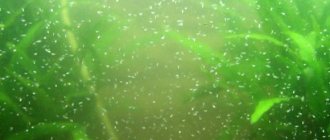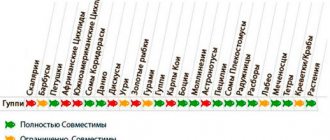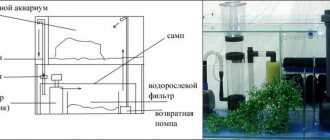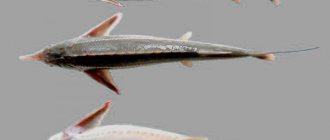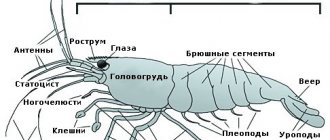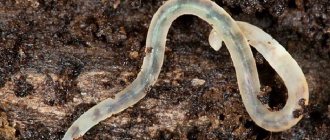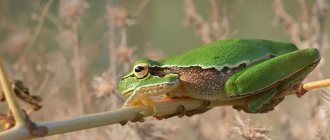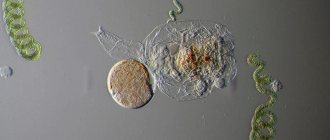The catfish family is one of the most common species of fish living in the aquarium. An individual feature of this family is the presence of bone plates instead of scales. There are approximately 800 species of catfish on the planet that live in aquariums. Among them you can find energetic and docile, predatory and herbivorous, etc.
Why do ancistrus have antennae?
Sabaj and colleagues (Sabaj et al., 1999) proposed a very interesting and plausible reason why male ancistrus develop a shaggy nose. In their studies, they found that males often guard several broods at the same time. In addition, scientists noted the preferential mating of females with males who are already guarding the brood and, perhaps, thus demonstrating the success of their reproductive strategy. In this case, the antennae developing on the muzzle theoretically reproduce the movements of the larvae and make the female believe that the male is already a successful parent and, therefore, a good sexual partner.
Compatibility with other fish
If you create suitable conditions for Ancistrus, they will be peaceful and calm. The best neighbors for them will be fish with similar conditions:
- gourami;
- zebrafish;
- characins;
- platies.
Many people write that they get along with goldfish, but this is not so. Often, aquarists are faced with situations where catfish attach themselves to goldfish and tear off their skin along with the meat. Ancistrus can chase phlegmatic, slow or scaleless fish during periods of bad mood and start fights.
Also, you should not put two males, territorial breeds and cichlids in the same aquarium - such proximity will lead to fierce fights that can end in failure for everyone.
The structure of the mouth allows catfish to inflict fatal wounds, but at the same time, because of it, they coexist peacefully with shrimp.
Short story
Ancistrus are a very popular aquarium fish, known since the early 1900s, that have earned a reputation as champion algae killers.
Unfortunately, both before and now there is confusion in the identification of species of the genus Ancistrus. The situation is further complicated by hobbyist aquarists who give different, speculative scientific names to almost every imported species. The most common among them are: A. cirrhosus, A. temminicki and A. dolichopterus. Although most wild specimens are extremely difficult to assign to a specific species, the situation has improved slightly in recent years.
Ancistrus cf. cirrhosus was for a long time known simply as Ancistrus sp. (3). This is the most common and accessible of the ancistrus, coming to the market from fish farms in Southeast Asia and Florida. Its specific characteristics have not been determined, so there is still an opinion that it is a hybrid. However, this is doubtful because the species has been bred for a long time without any variation, and specimens found in Europe, Australia and the United States appear to be the same species. Breeding practices have led to the emergence of albino (A. sp. 4), veiled (A. sp. 5) and even albino veiled forms.
Ancistrus cf. cirrhosus (Ancistrus sp. (3)) with juveniles (ill. www.istellas.gr)
Ancistrus triradiatus (aka LDA 72) is most often exported in the wild. Representatives of this species are caught in large quantities near the city of Villavicencio, Colombia. They inhabit waters at the base of mountains and can withstand relatively low temperatures (down to 22 °C). These catfish prefer fast water with a high oxygen content, but adapt to other conditions.
Ancistrus triradiatus (LDA 72) (ill. dfcdfc69; alquimistadeacuarios.com/foro/viewtopic.php?t=50031)
True specimens of Ancistrus dolichopterus (aka L183) are supplied from Rio Negro, Manaus. These attractive blackwater inhabitants require soft, warm water.
Types of catfish
Speckled Corridor
The average length of a male is from four to six centimeters, a female is up to seven centimeters. They are olive-brown in color with many dark spots. Their belly is yellow. The sides of the body have 2 lines of bony plates, and harsh spines are located on the dorsal and pectoral fins. The front of the head is decorated with a pair of antennae.
Ancistrus
Length - up to fourteen centimeters. The color varies, starting from light gray with a yellow tint and ending with dark gray with light spots. The crown of the slightly flattened body is the voluminous head. The first rays of the fins are much thicker than the others and are equipped with spines; there are lines of bony plates on the body. There are spines hidden at the base of the head. The male is emphasized by his full “horns,” elastic skin growths on his nose. Females are a little more massive, their growths are almost smooth.
Tarakatum
The average length is from sixteen to seventeen centimeters. The male is smaller than the female. Color: coral. There are large black spots that darken over the years. The belly of females is light, that of males is coral, and during breeding it is blue. The body is oblong, with a high dorsal crest, a flat belly and a thickened base of the tail. The lower part of the wide head is flat. There are 3 pairs of short antennae.
Pterygoplicht brocade
Length - up to twenty centimeters. The coloring echoes the leopard pattern: brown-black spots bordered with yellow are located on the body. Over the years, the picture becomes smaller and may disappear completely. The body is flattened and long. The scales are made up of bone plates. With a high dorsal fin, full pectoral and ventral fins.
Synodontis
The average length is from six to nine and a half centimeters.
The female is larger than the male. Gray-beige color with black-brown spots, belly slightly darker. With a stocky, slightly flattened body at the sides. The caudal fin has 2 blades and a triangular dorsal fin. Synodontis has large eyes and 6 antennae in the mouth area. We also recommend reading:
The largest dog breeds What is domestication in animal husbandry Why you should get a cat: reasons voiced by scientists Euthanasia of animals
White-spotted agamixis
Length - up to twelve centimeters. The female is more massive and duller. With brown-black color. Has pale yellow spots. The body is large and long. There are bone plates and spines. The head is large, flattened, with 3 pairs of speckled mustaches. The dorsal fin is triangular in shape. It has a tooth on the front ray, small and rounded ventral fins. The female has a remarkably large, unshaped belly.
Callicht
Size - up to fifteen centimeters. Coloring ranges from olive green to dark gray with large dark spots. In males, the anterior ray in the pectoral fin is notable for its orange color. The body is long, slightly flattened on the sides, on which there are 2 lines of bone plates; not the entire back is covered with them. The flattened upper part is voluminous with 3 pairs of antennae in the mouth area of the head.
Brohis
The average size is from eight to nine centimeters. The female is larger and has a more rounded belly. Brochis has a greenish color with a cast of sides, a brownish back and a bright yellow belly. These fish have a large head and a long body, which elastically smoothly descends towards the tail cover. On the flat sides there are 2 lines of strong plates and a two-lobed tail cover.
Catfish anchor
Length - up to three and a half centimeters. The female is longer and more massive. Coloring ranges from reddish-brown to dark brown with dark spots and stripes. The upper part of the body is curved, the size of the pectoral fins is proportionally long, and there are tubercles on the skin.
Interesting fact. The river catfish is distinguished by its extraordinary cunning. He hunts without moving. To lure prey, the catfish copies the worms with elastic movements of its antennae. At the moment when the victim is at a close distance from the catfish, it quickly sucks in water along with the victim.
Feeding ancistrus catfish
All ancistrus are omnivores, which, however, should be considered with caution. A fish eating a diet of 90% animal and 10% plant protein is omnivorous, as is a fish consuming 10% animal and 90% plant protein. Ancistruses fall into the second category. With the exception of A. ranunculus and its close relatives, ancistrus should receive a large amount of plant food and a small portion of animal protein. Individuals that are kept for a long time on “animal” frozen, dry or live food intended for aquarium neighbors become victims of intestinal blockage and bloating. In turn, bloating becomes lethal if the fish is not switched to a plant diet in time.
The basis of feed should be fresh vegetables. Ancistrus happily eat cucumbers, green and yellow pumpkins, asparagus stems, spinach leaves and broccoli stems. You can add some special food for plecostomus, which, as a rule, is prepared on the basis of shrimp or fishmeal and contains very little plant components. Live and frozen foods are also occasionally given as a supplement.
Ancistrus eat cucumbers
Nutrition
In nature and in aquarium conditions, the favorite food of the common ancistrus is the plaque that forms on driftwood, stones and glass, especially if the aquarium is well lit. In addition, it eats the remains of plant and live food that are not eaten by other fish. When there is a lack of algal growths, it switches to plant leaves, especially young ones, leaving holes on them.
To avoid damage to plants, it is necessary to feed the ancistrus with plant foods: leaves of cabbage, lettuce and nettle scalded with boiling water.
Reproduction of ancistrus in an aquarium
For hobbyists, the first experience of breeding loricariids is usually associated with ancistrus. To hone a beginner's skill, A. sp. 3 or A. triradiatus, which spawn easily under normal conditions. Although breeding of ancistrus often occurs in a common aquarium, those who have set the task of breeding catfish need to prepare a special single-species container. This requires at least one male and one female, and knowledge of sex determination.
When purchasing potential studs from one supplier, you need to be sure that you are purchasing individuals of the same species. Most aquarists breed Ancistrus sp. 3, or its various forms (albino, veil). If they are interested in breeding wild specimens specifically, A. triradiatus is a good option. It is recommended to start your practical experience in breeding with the inhabitants of black waters, which require some manipulations with the chemical composition of the water.
For many ancistrus, a spawning container with a volume of 80 liters is suitable. Representatives of the species Ancistrus sp. 3 also reproduce in a 40 liter aquarium. The common rule: “the larger the volume, the better” is also true in this case. Additionally, it is better to choose a container that is low but has a wide surface area. There should be no other fish in the spawning area. You can place a painted cardboard sheet under the bottom glass, or pour a thin layer of sand and gravel into the container. The absence of soil or a small amount of it will make maintenance easier.
You can choose any filtration method, but the powerful pump is always covered with foam rubber for the safety of the fry. There are no strict requirements for lighting, but it should not be too bright.
Depending on the volume, one, two females and one male are planted in the container. In a large spawning tank (120 liters) you can experiment by placing two males and several females. In a small area, two males spend too much time fighting for food, shelter, females and never spawn. The breeders should be approximately the same size, or it is better that the female be larger. A female that is too small can be beaten to death by a bully male.
The aquarium must include one or more spawning tubes. Although catfish also breed in clay pots, coconut shells, or on a piece of wood, they prefer PVC pipes as a substrate. In addition to pipes, it is advisable to place pieces of wood and shelter for females.
Species A. sp. 3 and A. triradiatus reproduce under similar conditions. The temperature in the aquarium is maintained in the range of 24-27 °C; soft or medium hard water with a pH of 6.5-7.6 is required. An important factor for successful spawning is cleanliness in the spawning area. You should replace 50% of the water weekly, or better yet twice a week by 25%. You cannot refresh the water daily because this will stress the fish.
How does the mating process occur?
For reproduction, a sexually mature pair of fish is needed, however, according to the recommendations of many breeders, there should be several females per male. The incentive to start spawning is a protein diet. During this period, the fish must be given live or frozen bloodworms, brine shrimp, daphnia, and tubifex.
Important! Catfish can eat their own eggs; therefore, 2 separate aquariums should be provided for spawning and raising offspring.
Catfish spawning
A group of mature males and females can spawn anywhere over the course of a week or month. To a large extent, the timing is determined by the condition of the fish at the time of purchase and the timing of maturation for spawning. The first sign of its end is the male, who climbs into the tube and beats his fins rhythmically. At this stage, the aquarist decides whether to leave the clutch to the male or place it in an incubator. The male's care has one positive aspect - he provides the eggs with everything they need. On the other hand, there are also disadvantages. The male may become nervous and eat the clutch. In addition, newly emerged fry are much more difficult to remove than eggs. If the clutch is nevertheless transferred, it should be placed in a mesh cage located in the spawning tank and gently aerated from above with a sprayer located 3-6 cm above the eggs. With good care of the aquarium, the masonry rarely becomes covered with fungus or is subject to other ailments.
Conditions of detention
Ancistrus vulgaris Source: www.seriouslyfish.com
It is advisable to have at least 50 liters of aquarium volume per ancistrus catfish - despite their small size, they need space. The aquarium landscape should be varied, with many shaded shelters, snags, and thickets of plants. Ancistrus do not like bright light and during the daytime they prefer to hide in the shadows. They feel most comfortable at a temperature of 22-25 °C, but in general they are quite unpretentious and can exist in the range of 17-30 °C. It is recommended to keep them in clean, oxygen-rich water.
Ancistrus need shelter in the form of driftwood, coconut shells, caves and artificial shelters.
Caviar and fry of aquarium ancistrus
The clutch is yellowish or orange in color, which is probably due to the diet of the catfish, and includes 30-100 eggs. The incubation period depends on the water temperature and is usually 5 days. If the clutch was at the disposal of the male, then at the end of incubation he will guard the fry for another 24-48 hours, and then begin to crawl out of the tube in search of food. In an aquarium with more than one female, the male may guard several clutches at once. Early removal of eggs often causes stress in the male as he rushes about for 1-2 days.
Masonry of Ancistrus sp. (3) on the glass of the aquarium. The first (1), second (2), third (3), fourth (4) and fifth (5,6) days of incubation (ill. www.youtube.com/watch?v=acIlyFgin6w). The larvae hatch from eggs, the shell of which is eaten by the male.
Raising juveniles
After 24-48 hours, the fry begin to swim freely and need food. The starting food for them is fresh vegetables and dry fish food. For 1-2 days, juveniles may ignore vegetables, but over time they begin to perceive them as food.
A spare 80 liter aquarium will be a good home for the fry. Naturally, it must be equipped with filtration and heating. Unlike the spawning tank, it is necessary to change 20% of the water daily. After 4-6 weeks, you can notice that some of the fry have become much larger than their counterparts. To avoid cannibalism, larger and more aggressive individuals must be transplanted into a second aquarium. With a length of 3 cm, juveniles can be placed in a nursery container with a volume of 100 liters or more. Even with an average brood of 50-70 individuals, the aquarist will soon need additional containers.
After successfully breeding several generations of A. sp 3 or A. triradiatus, you may be tempted to target more attractive and challenging black water dwellers such as Ancistrus dolichopterus. Representatives of this species are bred according to the rules stated above with two exceptions. Firstly, they need very soft, acidic (pH less than 6.8) and warm (27-29 °C) water. To obtain it, a reverse osmosis installation is required. Secondly, these ancistrus require a diet rich in protein and should receive meat food more than twice a week.
Description
This catfish, like many other fish, was discovered in South America, and it came to us only after 1970. The fish got into home aquariums primarily because of its exotic appearance:
- due to its benthic lifestyle, the Ancistrus body has a teardrop-shaped, flattened shape;
- There are bony plates throughout the body designed to withstand predators;
- the color depends on the specific breed of fish;
- The main difference from other catfish is the shape of the mouth - it looks like a suction cup.
These fish do not grow too large - they reach a length of 20 centimeters. With proper care, they can live up to 7 years in a home aquarium, although in nature they most often die earlier.

